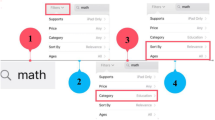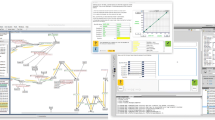Abstract
Personalizing the use of educational mathematics applets to fit learners’ characteristics poses a great challenge. The present study adopted a unique approach by comparing personalization processes implemented by a machine to those implemented by a human teacher. Given the different affordances—the machine’s access to historical log file data, computation and automatization, and the teacher’s mathematical knowledge, pedagogical approach and personal acquaintance—the study hypothesized that different considerations would lead to different personalization and learning outcomes. Mathematical applets were assigned to 77 students in the 4th and 5th grades either by an expert teacher or by an algorithm. The assignment took place in a controlled setting in which the teacher was unaware which students were eventually assigned according to her recommendations. The teacher and the machine each recommended an ordered sequence of ten applets per student. The findings suggest that the teacher-assigned group outperformed the machine-assigned group among 5th graders when the applets were sequenced in increasing order of difficulty. In the 4th grade, only the machine recommended a sequence of increasing difficulty and both groups achieved equal performance. The study concludes that in the case of data-driven personalization processes, machines and teachers should learn from each other’s affordances and considerations.











Similar content being viewed by others
References
Adomavicius, G., & Tuzhilin, A. (2011). Context-aware recommender systems. In F. Ricci, L. Rokach, B. Shapira, & P. B. Kantor (Eds.), Recommender systems handbook (pp. 217–253). New York: Springer. https://doi.org/10.1007/978-0-387-85820-3
Al-Sharrah, G. (2010). Ranking using the Copeland Score: A comparison with the Hasse Diagram. Journal of Chemical Information and Modeling, 50(5), 785–791. https://doi.org/10.1021/ci100064q
Ben David, Y., Segal, A., & Gal, Y. (2016). Sequencing educational content in classrooms using Bayesian knowledge tracing. In Proceedings of the sixth international conference on learning analytics & knowledge - LAK ’16 (pp. 354–363). Edinburgh, UK. https://doi.org/10.1145/2883851.2883885
Ben-Haim, E., Cohen, A., & Tabach, M. (2019). Types of graphic interface design and their role in learning via mathematical applets at the elementary school. In Eleventh congress of the European society for research in mathematics education, Utrecht, Netherland. https://hal.archives-ouvertes.fr/hal-02422151/document
Birch, S. H., & Ladd, G. W. (1997). The teacher-child relationship and children’s early school adjustment. Journal of School Psychology, 35(1), 61–79. https://doi.org/10.1016/S0022-4405(96)00029-5
Bray, A., & Tangney, B. (2017). Technology usage in mathematics education research–a systematic review of recent trends. Computers and Education, 114, 255–273. https://doi.org/10.1016/j.compedu.2017.07.004
Burke, R. (2000). Knowledge-based recommender systems. Encyclopedia of Library and Information Systems, 69(32), 175–186.
Chen, C.-M. (2008). Intelligent web-based learning system with personalized learning path guidance. Computers & Education, 51(2), 787–814. https://doi.org/10.1016/j.compedu.2007.08.004
Dascalu, M.-I., Bodea, C.-N., Moldoveanu, A., Mohora, A., Lytras, M., & de Pablos, P. O. (2015). A recommender agent based on learning styles for better virtual collaborative learning experiences. Computers in Human Behavior, 45, 243–253. https://doi.org/10.1016/J.CHB.2014.12.027
Erdt, M., Fernandez, A., & Rensing, C. (2015). Evaluating recommender systems for technology enhanced learning: A quantitative survey. IEEE Transactions on Learning Technologies, 8(4), 326–344. https://doi.org/10.1109/TLT.2015.2438867
Faria, A.-M., Greenberg, A., Meakin, J., Bichay, K., & Heppen, J. (2014). Replicating the relationship between teachers’ data use and student achievement: The urban data study and the data dashboard usage study. Society for Research on Educational Effectiveness, 1-8.
Forster, P. A. (2006). Assessing technology-based approaches for teaching and learning mathematics. International Journal of Mathematical Education in Science and Technology, 37(2), 145–164.
García, E., Romero, C., Ventura, S., & de Castro, C. (2009). An architecture for making recommendations to courseware authors using association rule mining and collaborative filtering. User Modeling and User-Adapted Interaction, 19(1–2), 99–132. https://doi.org/10.1007/s11257-008-9047-z
Haleva, L., Hershkovitz, A., & Tabach, M. (2020). Students’ activity in an online learning environment for Mathematics: The role of thinking levels. Journal of Educational Computing Research, Online First. https://doi.org/10.1177/0735633120972057
He, X., Liao, L., Zhang, H., Nie, L., Hu, X., & Chua, T.-S. (2017). Neural collaborative filtering. In Proceedings of the 26th International Conference on World Wide Web - WWW ’17 (pp. 173–182). New York: ACM Press. https://doi.org/10.1145/3038912.3052569
Hershkovitz, A., Tzayada, O., Ezra, O., Cohen, A., Tabach, M., Levy, B.,…Gal, K (2019). Can an algorithm prepare students to tasks without knowing what the tasks are? In Proceedings of the 2019 international conference on computational science and computational intelligence (CSCI'19), Las Vegas, USA.
Higgins, K., Huscroft-D’Angelo, J., & Crawford, L. (2019). Effects of technology in mathematics on achievement, motivation, and attitude: A meta-analysis. Journal of Educational Computing Research, 57(2), 283–319. https://doi.org/10.1177/0735633117748416
Khribi, M. K., Jemni, M., & Nasraoui, O. (2008). Automatic recommendations for e-learning personalization based on web usage mining techniques and information retrieval. The Eighth IEEE International Conference on Advanced Learning Technologies, Santander, Cantabria, Spain. https://doi.org/10.1109/ICALT.2008.198
Khribi, M. K., Jemni, M., & Nasraoui, O. (2009). Automatic recommendations for e-learning personalization based on web usage mining techniques and information retrieval. Educational Technology & Society, 12(4), 30–42.
Kickmeier-Rust, M. D., Steiner, C. M., & Albert, D. (2014). Towards a hybrid approach to learning analytics, educational data mining, and personalization for serious games. Learning Analytics for and in Serious Games, 29–32.
Luckin, R. (2001). Designing children’s software to ensure productive interactivity through collaboration in the zone of proximal development (ZPD). Information Technology in Childhood Education Annual, 2001(1), 57–85.
Mandinach, E. B. (2012). A perfect time for data use: Using data-driven decision making to inform practice. Educational Psychologist, 47(2), 71–85. https://doi.org/10.1080/00461520.2012.667064
Manouselis, N., Drachsler, H., Vuorikari, R., Hummel, H., & Rob, K. (2011). Recommender systems in technology enhanced learning. In F. Ricci, L. Rokach, B. Shapira, & P. B. Kantor (Eds.), Recommender systems handbook (pp. 387–415). New York: Springer. https://doi.org/10.1007/978-0-387-85820-3
Mawata, C. P. (1998 ). Uses of Java applets in mathematics education. In Asian technology conference in mathematics (ATCM). Retrieved from https://atcm.mathandtech.org/EP/1998/ATCMP016/paper.pdf
Molenaar, I., & Knoop-van Campen, C. A. (2018). How teachers make dashboard information actionable. IEEE Transactions on Learning Technologies, 12(3), 347–355.
Mouri, K., Ogata, H., Uosaki, N., & Lkhagvasuren, E. (2016). Context-aware and personalization method based on ubiquitous learning analytics. Journal of Universal Computer Science, 22(10), 1380–1397.
Park, H., & Song, H. D. (2015). Make E-learning effortless! Impact of a redesigned user interface on usability through the application of an affordance design approach. Educational Technology & Society, 18(3), 185–196.
Radović, S., Radojičić, M., Veljković, K., & Marić, M. (2020). Examining the effects of Geogebra applets on mathematics learning using interactive mathematics textbook. Interactive Learning Environments, 28(1), 32–49.
Ricci, F., Rokach, L., & Shapira, B. (2011). Introduction to recommender systems handbook. In F. Ricci, L. Rokach, B. Shapira, & P. B. Kantor (Eds.), Recommender systems handbook (pp. 1–35). New York: Springer. https://doi.org/10.1007/978-0-387-85820-3
Romero, C., Ventura, S., Zafra, A., & de Bra, P. (2009). Applying Web usage mining for personalizing hyperlinks in Web-based adaptive educational systems. Computers & Education, 53(3), 828–840. https://doi.org/10.1016/j.compedu.2009.05.003
Santos, O. C., & Boticario, J. G. (2012). Affective issues in semantic educational recommender systems. In Proceedings of the 2nd workshop on recommender systems in technology-enhanced learning (pp. 71–82). Saarbrücken, Germany: RecSysTEL@EC-TEL.
Schifter, C., Natarajan, U., Ketelhut, D. J., & Kirchgessner, A. (2014). Data-driven decision-making: Facilitating teacher use of student data to inform classroom instruction. Contemporary Issues in Technology and Teacher Education, 14(4), 419–432.
Schunk, D. H. (2000). Learning theories: An educational perspective (3rd ed.). . Merrill.
Schunk, D. H. (2012). Learning theories: An educational perspective (6th ed.). . Pearson.
Segal, A., Katzir, Z., Gal, K., Shani, G., & Shapira, B. (2014). EduRank: A collaborative filtering approach to personalization in e-learning. In Proceedings of the 7th international conference on educational data mining (pp. 68–75), London, UK.
Shishehchi, S., Banihashem, S. Y., Zin, N. A. M., & Noah, S. A. M. (2011). Review of personalized recommendation techniques for learners in e-learning systems. International Conference on Semantic Technology and Information Retrieval, Putrajaya, Malaysia. https://doi.org/10.1109/STAIR.2011.5995802
Shulman, L. S. (1986). Those who understand: Knowledge growth in teaching. Educational Researcher, 15(2), 4–14. https://doi.org/10.3102/0013189X015002004
Strauss, S. (2001). Folk psychology, folk pedagogy, and their relations to subject-matter knowledge. In B. Torff & R. J. Sternberg (Eds.), Understanding and teaching the intuitive mind: Student and teacher learning (pp. 215–240). Lawrence Erlbaum Associates.
Verbert, K., Manouselis, N., Ochoa, X., Wolpers, M., Drachsler, H., Bosnic, I., & Duval, E. (2012). Context-aware recommender systems for learning: A survey and future challenges. IEEE Transactions on Learning Technologies, 5(4), 318–335. https://doi.org/10.1109/TLT.2012.11
Verbert, K., Ochoa, X., Derntl, M., Wolpers, M., Pardo, A., & Duval, E. (2012). Semi-automatic assembly of learning resources. Computers & Education, 59(4), 1257–1272. https://doi.org/10.1016/j.compedu.2012.06.005
Walkington, C. A. (2013). Using adaptive learning technologies to personalize instruction to student interests: The impact of relevant contexts on performance and learning outcomes. Journal of Educational Psychology, 105(4), 932–945. https://doi.org/10.1037/a0031882
Walkington, C. A., & Bernacki, M. L. (2019). Personalizing algebra to students’ individual interests in an intelligent tutoring system: Moderators of impact. International Journal of Artificial Intelligence in Education, 29(1), 58–88. https://doi.org/10.1007/s40593-018-0168-1
Xhakaj, F., Aleven, V., & McLaren, B. M. (2017). Effects of a teacher dashboard for an intelligent tutoring system on teacher knowledge, lesson planning, lessons and student learning. In Lecture notes in computer science (including subseries lecture notes in artificial intelligence and lecture notes in Bioinformatics): Vol. 10474 LNCS (pp. 315–329). Springer, Cham. https://doi.org/10.1007/978-3-319-66610-5_23
Yilmaz, E., Aslam, J. A., & Robertson, S. (2016). A new rank correlation coefficient for information retrieval. In Proceedings of the sixth international conference on learning analytics & knowledge (pp. 587–594). Singapore. Retrieved from http://www.ccs.neu.edu/home/jaa/tmp/RankCorrelation.pdf
Zou, X., Ma, W., Ma, Z., & Baker, R. S. (2019). Towards Helping Teachers Select Optimal Content for Students. In International conference on artificial intelligence in education (pp. 413–417). Cham: Springer.
Acknowledgements
This study was supported by the Israeli Ministry of Education (Program 35/12.15, “Promoting Technologies for Domain-Specific Teaching”).
Author information
Authors and Affiliations
Corresponding author
Ethics declarations
Conflict of interest
None.
Additional information
Publisher's Note
Springer Nature remains neutral with regard to jurisdictional claims in published maps and institutional affiliations.
Rights and permissions
About this article
Cite this article
Cohen, A., Ezra, O., Hershkovitz, A. et al. Personalizing mathematical content in educational applets repository: human teacher versus machine-based considerations. Education Tech Research Dev 69, 1505–1528 (2021). https://doi.org/10.1007/s11423-021-10002-x
Accepted:
Published:
Issue Date:
DOI: https://doi.org/10.1007/s11423-021-10002-x




